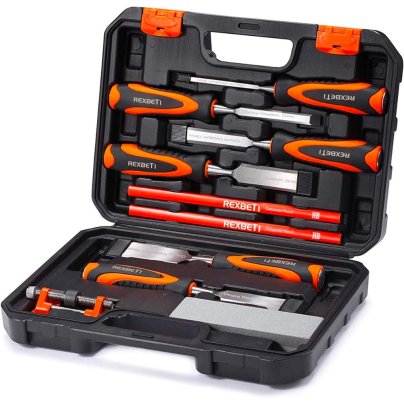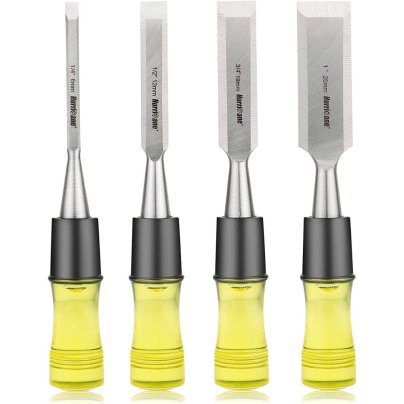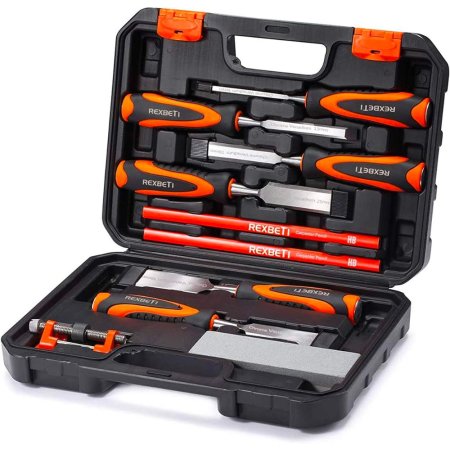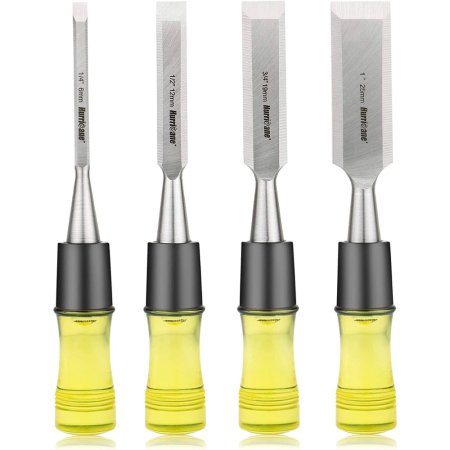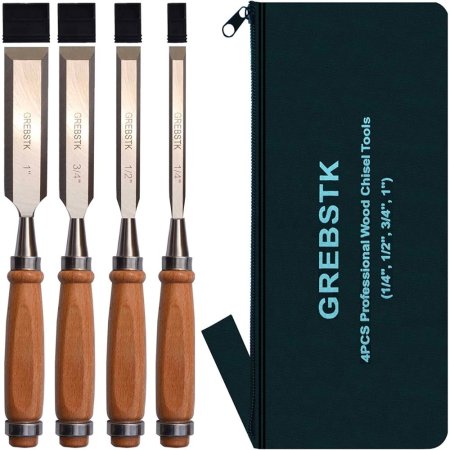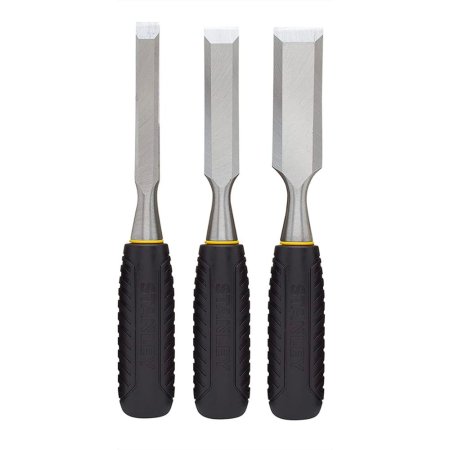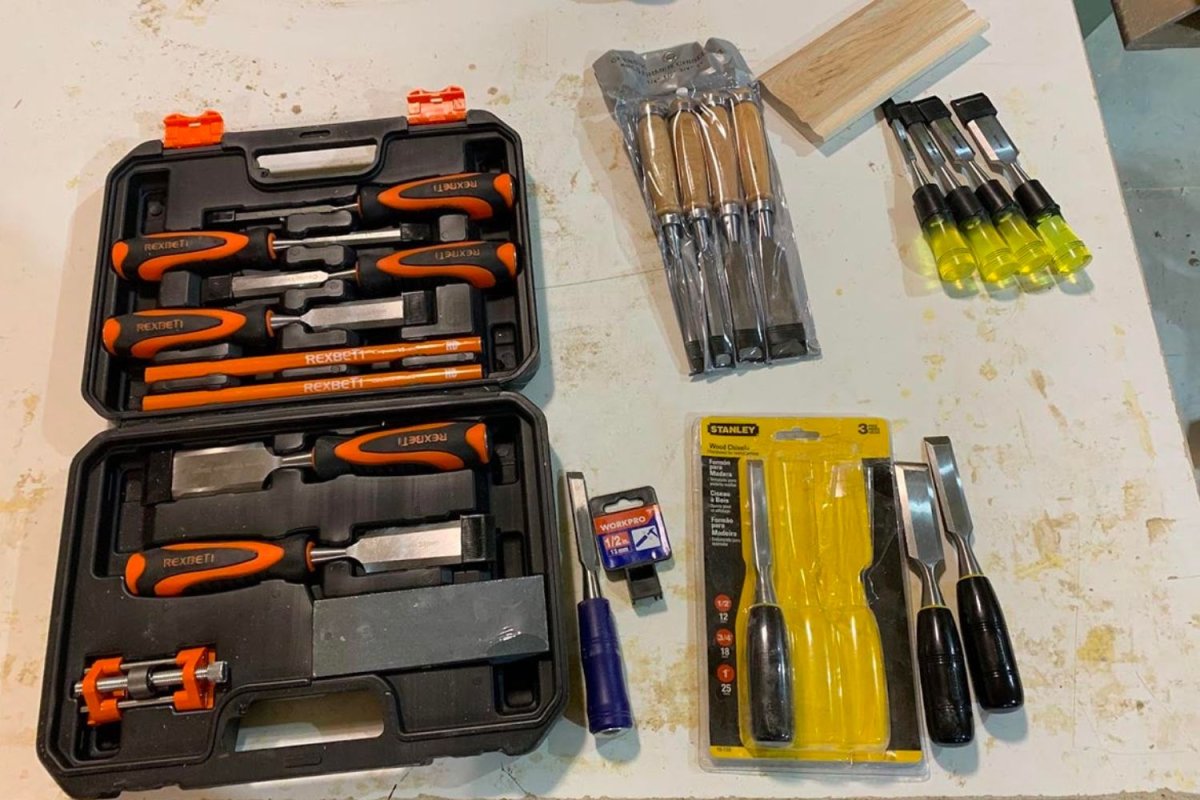
We may earn revenue from the products available on this page and participate in affiliate programs. Learn More ›
Metal hand tools with either a straight or beveled edge, chisels have been around for thousands of years, standing the test of time as a woodworking essential. They’re used to shave off excess wood, fashion intricate wood joints, and carve out custom designs. Wood chisels are a necessity for making fine furniture, and all serious woodworkers need a quality set at their disposal.
But buying the wrong type of chisels for the job—or an inferior product—is a waste of money, so we performed hands-on testing on a number of models to home in on the best wood chisels available. Use this guide to learn the vital factors and features to look for when shopping, and check out our specific product recommendations.
- BEST OVERALL: Rexbeti 10-Piece Premium Wood Chisel Set
- BEST BANG FOR THE BUCK: Hurricane 4-Piece Cr-V Steel Wood Chisel Set
- BEST INTRO CHISEL SET: Grebstk 4-Piece Professional Wood Chisel Tool Set
- BEST ALL-PURPOSE CHISEL: Stanley 16-150 3-Piece Wood Chisel Set
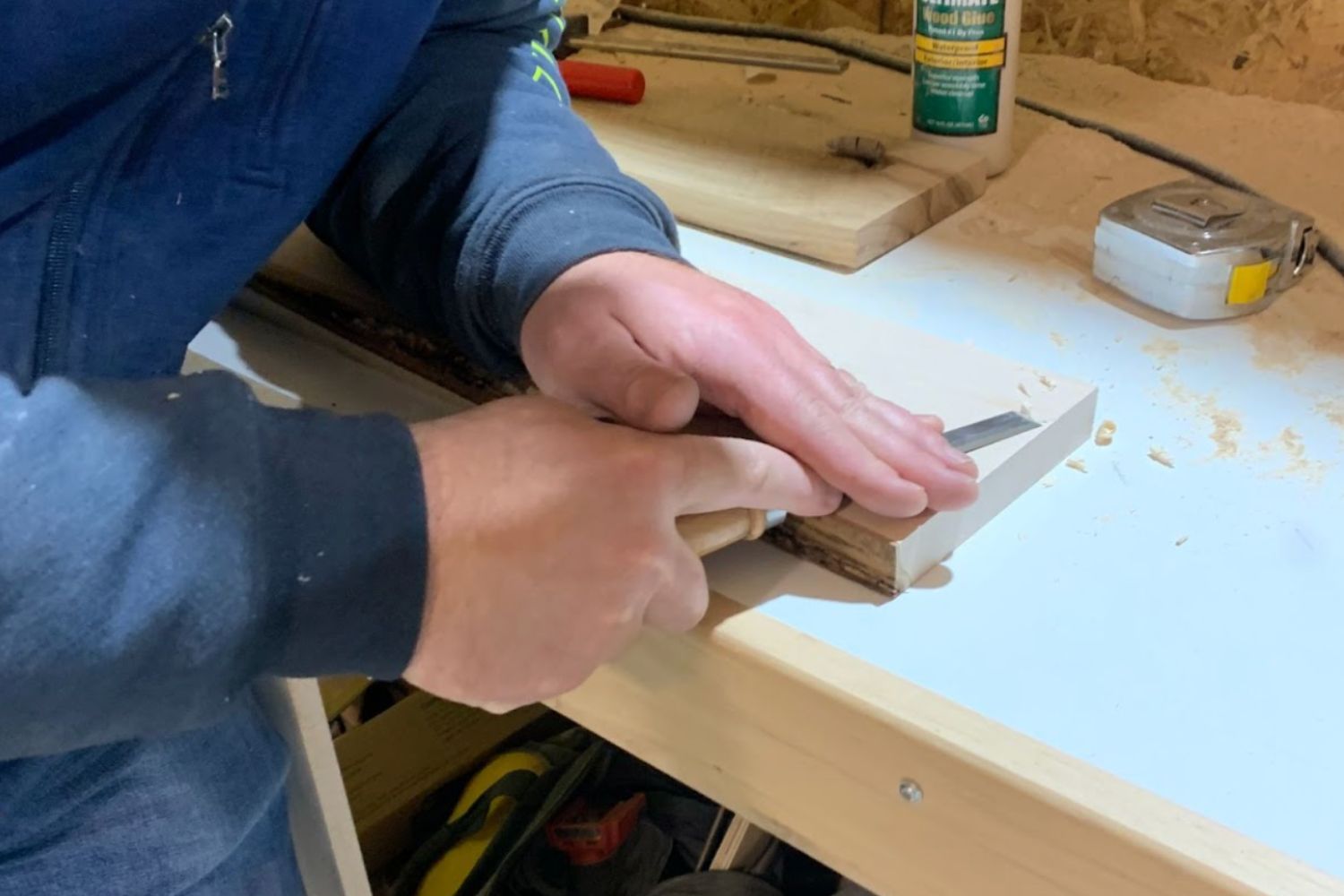
How We Tested the Best Wood Chisels
All of the following woodworking chisels were tested in the manufacturing process for real kitchens by a professional woodworker in a Michigan cabinetmaking shop. In choosing these chisels, we considered first and foremost the overall finish of the blade, whether the casting is square or pitted, and the quality of the metal. After all, a well-finished blade will affect the quality of the work. For versatility, we looked for sets that had a good number of different-size chisels. And, although it’s best to sharpen chisels prior to use, we considered how well the chisels worked right out of the box.
Our Top Picks
We put a number of popular chisels through their paces in a professional woodworking shop to help consumers make the right choices for their projects, skill level, and budget. Our criteria included three key features that anyone, from a beginner to a master craftsperson, would consider:
- Metal finish: This refers to the overall finish of the blade, whether the casting is square or pitted, and the quality of the metal. A well-finished blade will affect the quality of work.
- Size: Woodworkers will use different-size chisels for different tasks, from fine joinery to larger projects.
- First cut: This pertains to how well the chisel tool works right out of the box, even though these tools should be sharpened prior to use.
Best Overall
Rexbeti 10-Piece Premium Wood Chisel Set
Pros
- Great value; comes with several chisels for different projects
- Wide range of chisel sizes included; suitable for small to large chiseling tasks
- Sturdy storage case included for safe storing and transporting
- Rubber grip is comfortable for many chisel uses; does not cause strain to hands or wrists
Cons
- Not for fine-end woodworking; suitable for small to medium-size adjustments
- Sharpening stone not high quality; additional purchase of a sharpener may be required
- Metal finish may not be smooth; may leave unwanted marks or scratches
Product Specs
- Metal finish: Rough
- Sizes: 6 mm, 13 mm, 19 mm, 25 mm, 32 mm, 38 mm
- First cut: Not the sharpest; dulled easily
This best chisel set is geared toward beginners and would be a good choice for tackling minor home repairs or a first woodworking project. It contains six chisels from ¼ inch to 1½ inches, a sharpening stone, a honing guide, two carpenter pencils, and a carrying case. The six chisels are of decent quality, and the size range is adequate, from 6 mm (good for accessing tight shoulders, as when creating a tenon) all the way to 38 mm (ideal for such tasks as flattening out the cheek of the tenon).
The vanadium steel blades are factory sharpened, but since we detected a burr on the edge, we can’t say that they were sharpened particularly well. Fortunately, the included sharpening stone comes with two grits, one coarse and one more fine for enhanced sharpening.
The chisels feel really good in the hand, thanks to a rubber grip for comfort—a bonus during rough carpentry, like whipping up a backyard shed. The hardened plastic handles have metal striking caps to be extra resilient against regular malleting. The metal strike plate on the bottom of each chisel makes us think they’re designed to withstand hits with a metal hammer.
Get the Rexbeti wood chisel at Amazon.
Best Bang for the Buck
Hurricane 4-Piece Cr-V Steel Wood Chisel Set
Pros
- Ideally sized for a nail bag; great for portability on the jobsite
- Easy to hold and fit nicely in the hand for user-friendliness
- Easy to carry all at once; small and lightweight constructions
Cons
- Small sizes only; may not be suitable for heavy-duty projects
- Composite/plastic butt end without metal could negatively affect longevity
Product Specs
- Metal finish: Midrange finish
- Sizes: ¼ inch, ½ inch, ¾ inch, and 1 inch
- First cut: Surprisingly sharp; kept the edge longer than expected
The craftsperson on a budget may find this classic four-piece set from Hurricane to be just right. The ¼-, ½-, ¾-, and 1-inch vanadium steel blades are sharp and heat treated for durability. The chisels were surprisingly sharp out of the box and retained their edge. Plus, they come pretreated with a lacquer surface coating to lubricate and protect the blades.
The handle is made from impact-resistant hardened plastic that won’t split from the force of a mallet. While we found them a bit short (a few hits to the hand during use), they fit comfortably in the hand while paring.
This chisel set is meant to be carried in a nail bag. Although a storage case isn’t included, the chisels come with four plastic protection caps to protect the blades when not in use. This set also lacks a sharpening device. These limitations are no surprise, considering the very reasonable price.
Get the Hurricane wood chisel at Amazon.
Best Intro Chisel Set
Grebstk 4-Piece Professional Wood Chisel Tool Set
Pros
- Works well right out of the box; no assembly required
- Nice length for fine woodworking and precision chiseling projects
- Sharpened well; may not require resharpening for some time
- Comes with a zip case for easy carrying and portability
Cons
- Poor handle finish; may be uncomfortable or tarnish and wear over time
Product Specs
- Metal finish: Smooth
- Sizes: ¼ inch, ½ inch, ¾ inch, 1 inch
- First cut: Sharp
Those ready to try their hand at the best chisel for woodworking might find this chisel set to be a great way to get started. It includes four sizes (¼ inch, ½ inch, ¾ inch, and 1 inch), and while somewhat short, all are long enough for paring tasks. Each chisel is packaged separately for protection and comes with its own guard, and a zippered carrying case is included.
The blade edges, made of chrome vanadium steel (Cr-V), feature a decent finish. They come very sharp, slightly oiled, and have a micro-bevel. The weight of the blade balances nicely with a lightweight beechwood handle and a stainless steel hoop for an ideal combination of strength and comfort. While the chisels didn’t seem like the most durable tools available, the set is a good value and a fine introduction to the craft.
Get the Grebstk wood chisel at Amazon.
Best All-Purpose Chisel
Stanley 16-150 3-Piece Wood Chisel Set
Pros
- Very comfortable to use; rubberized grips fit well in hand and won’t cause fatigue
- Easy to resharpen in case of wear and tear; blades are durable enough for multiple resharpenings
- 3 versatile tools; can be used for small- to large-scale chiseling
Cons
- Guards not included; not as safe during storage as comparable options
- Poor packaging materials may cause damage before the chisels arrive
- Handles felt slightly underweight; may be harder to control than heavyweight chisels
Product Specs
- Metal finish: Midgrade; there was a nick on one of the chisels
- Sizes: ½ inch, ¾ inch, and 1 inch
- First cut: Good, aside from one chipped chisel
First impressions can be deceiving. This chisel set came in standard plastic packaging (not even a separate box for shipping)—a potential red flag to the condition and quality of the tools. And right off the bat, we did notice a mix of finishes and even a significant chip in one chisel, most likely due to the lack of appropriate packaging.
But in our tests, this three-chisel set soon proved worthy. In fact, while we were building a new kitchen, the chisels became our go-to for cutting drawer slide notches. Sizes include ½, ¾, and 1 inch, all with 7¾ inches in length: not too short to use to pare yet small enough to carry around in a bag. The blades on these Stanley chisels are carbon steel, while the comfortable handles are built with black polypropylene, a combination that made these chisels easy to hold, control, and work with. Overall we found them to be good for rough carpentry and fine woodworking—truly all-purpose chisels.
Get the Stanley wood chisel at Amazon or The Home Depot.
Also Tested
The Irwin is a very specialized chisel for those doing very fine joinery. It will be helpful for small wooden projects, but it’s not one we recommend for the all-purpose worker. The WorkPro simply didn’t seem to be the type of chisel that would be effective for a variety of projects.
Jump to Our Top Picks
Types of Wood Chisels
There are many different wood chisels, but only three chisel types are considered staples among woodworkers: the bench chisel, mortise chisel, and paring chisel. These three will accomplish the vast majority of tasks, so understanding how they function is a crucial first step in determining your needs.
Bench Chisels
Bench chisels are the most commonly used type of chisels because of their multipurpose functionality. They’re designed with versatility in mind and can do everything from cutting out wood joints in cabinets to shaving lumber in rough framing. In fact, the term “bench chisel” comes from the idea that they often permanently reside on a woodworker’s bench, ready for immediate use.
A bench chisel can either have a straight or beveled edge, with the beveled-edge version being the most common. The bevel grants a better overall balance to the chisel and more easily accommodates the sidewalls of different joints. The straight-edged variety (called the “firmer” bench chisel) doesn’t share these features but is thicker and heavier for carving large sections of hard material. Both types are available in sizes from 1/16 to 3 inches, with the most useful sizes being between ¼ inch and 1 inch. A quality set of these chisels can handle almost any task thrown at them, as long as they’re treated properly and used only with a wooden mallet instead of a metal hammer.
Mortise Chisels
The mortise and tenon joint is a popular joinery technique in cabinetry, and the mortise chisel is designed specifically with this task in mind. While the bench chisel is theoretically capable of producing these joints, it cannot withstand the pounding and prying demands of regular mortising. In fact, using a bench chisel is bound to quickly chip the blade or mushroom the handle, which is why the mortise chisel was developed in the first place.
Mortise chisels are large, thick, and heavy, making them ideal for carving out deep mortises in the toughest hardwood. A smaller mortise chisel (called a “sash”) is also good to have on hand for those who do more intricate mortise work than the standard, bulky mortise chisel can produce. Both varieties come in sizes ranging from ⅛ to ½ inch, with the most common being ¼ inch. The sash, however, will have a lighter handle and be easier to navigate for finer detail work.
Paring Chisels
With their long, thin blades ideal for accessing tight spaces, paring chisels produce small, intricate joints in finish carpentry. While they can be used as stand-alone joinery tools, paring chisels are frequently used in conjunction with a bench or mortise chisel. In this case, a mortise chisel will carve out a “rough” joint to be later refined with the fine action of the paring chisel.
Pro tip: Use only the force of your hand, not a mallet, to produce cutting power with a paring chisel. Doing so ensures that you won’t apply too much pressure and remove an excessive amount of material while making meticulous cuts.
What to Consider When Choosing Wood Chisels
Within the three primary categories of wood chisels, there are several factors to consider when choosing the right one for you. It is useful to know what you’ll be using them for, the differences between the handle and blade types, and certain accessories you may need.
Purpose
First and foremost, determine how you’ll primarily be using chisels to avoid wasting money and shop space on tools you don’t need. For example, if your next project will require many mortise and tenon joints, buying a set of bench chisels will likely result in broken handles and damaged blades. However, if you do a variety of projects with diverse woodworking tasks, an all-purpose set of bench chisels with multiple sizes may be just the ticket.
In short:
- Get a bench chisel (or a set in different sizes) if you’re unsure exactly what you’ll need to chisel.
- Choose a mortise chisel if you’re planning on making multiple deep mortises (especially in hardwood).
- Select a paring chisel if crafting fine furniture or cabinets that require detailed shaving and joints.
Socket vs. Tang Handle
Chisels can be broadly divided into either socket or tang types, depending on how the blade’s base (also called the shank) is secured to the handle. A socket chisel has a shank with a cupped indentation (aka, a socket) that fits into a corresponding cone-shaped protrusion from the handle. Conversely, a tang chisel has a pointed shank (aka, a tang) that fastens to the handle.
Socket chisels are usually more popular, yet more expensive, than tang chisels because of their greater durability. Tang types are less resilient against regular use because the connection between handle and blade can loosen over time. A tang is designed with the metal on the end of the blade secured through friction into the handle, while a socket has the handle fit directly into the blade. However, tang chisels can still enjoy a long life when used correctly and with care.
Handle Material
A chisel’s grip can either be made from wood or plastic. Wood-handled chisels are beautiful, well-balanced, and sturdy—so not surprisingly, they’re preferred by experienced craftsmen willing to pay a little extra for that look and feel. The downside is that wood-handled chisels tend to be more expensive and relatively less durable than plastic options.
Plastic handles feature either hard- or soft-grip plastic. Hard plastics are made from PVC, which is cheap and highly impact resistant. They tend to be stronger than soft-grip handles composed of a rubber and hard plastic mixture, but soft-grip models are generally more comfortable to use. Thanks to their lower price point and more forgiving nature, plastic handles are typically preferred by beginner woodworkers who may need a more affordable and resilient option.
Blade Material
Most chisel blades are made from either carbon or vanadium steel. Carbon steel (also called tool steel) has carbon added to the iron to make it harder. The carbon content of most chisels is 0.6 percent to 0.75 percent, but they can also be made out of high-carbon steel with carbon content up to 1.7 percent. As a general rule, the hardness of the blade determines how long it will stay sharp and how long it takes to resharpen.
Vanadium steel has a small amount of vanadium added to make the steel stronger and tougher than carbon steel. This helps the blade retain a sharp edge for longer than ordinary tool steel, which is one reason vanadium steel is also used in surgical tools that require multiple precision cuts without dulling the edge.
Western vs. Japanese Chisel
The debate over whether Western or Japanese chisel sets are superior has raged for decades. At the heart of this debate are two critical differences in how the chisels are made. Japanese chisels are made from much harder steel (high carbon with low contaminates and added tungsten), while most Western chisels feature either regular tool steel or vanadium. Each type has its advantages and disadvantages. Generally, softer Western steel dulls quicker but is easier to sharpen, while the harder Japanese steel will maintain a sharp edge but takes longer to sharpen. For this reason, Japanese steel is seen as best for jobs requiring regular malleting without having to take frequent breaks to sharpen the blade.
Another key difference is the shape of the blades and handles, with Japanese chisels having shorter blades and more cylindrical (less ergonomic) handles than their Western counterparts. The specific advantages and disadvantages of these different shapes and sizes are largely a matter of personal preference.
Despite the differing views, most will agree that the two styles can complement one another nicely. Experiment with them both to see which suits you best.
Width and Length
The width of chisel blades vary and are largely dependent on the chisel’s type and purpose. Depending on type, the width may be as small as 1/16 inch all the way up to 3 inches. More detail-oriented work will require a smaller chisel, while larger projects (like framing) would require larger (1½- to 3-inch) chisels.
A chisel’s length can differ considerably too. Longer blades give the greatest control and are ideal when working with flat or otherwise easily accessible surfaces. This is why paring chisels have thin, long blades to provide greater control. Shorter chisels are good for getting into tight places where a longer blade can’t. Ideally, a well-equipped wood workshop will include chisels of varying lengths and widths.
Accessories
When investing the time, effort, and expense to find the perfect wood chisels, it also makes sense to consider accessories that will keep them sharp and safely stored for years to come. The right sharpening device and storage method will help preserve and maintain the investment.
Most chisels don’t come factory sharpened, so it’s up to the user to sharpen chisels before use. There are several sharpening options, including a sharpening stone (oil stone, water stone, or diamond stone), bench grinder, and sandpaper.
Storage options may include a case (such as a plastic or wooden box), a canvas pouch, a wall-mounted or free-standing rack, or a magnetic tool holder.
Users will also need a good wooden mallet to properly work with chisels without causing damage.
Tips for Buying and Using Wood Chisels
Consider these specific tips to help you make the right decision when purchasing chisels.
- Let your experience level lead you. If you’re a beginner, a flashy set of wooden-handled paring chisels may lead to broken handles and wasted money. If you’re an advanced craftsperson, a plastic-handled chisel will lack the necessary balance and “feel” that a wooden handle provides. Being honest about where you reside on the spectrum of experience will help you make the wisest choice.
- Keep the purpose in mind. Select chisels based on intended use: bench chisels for general-purpose shaving and joining, mortise chisels for deep mortises, and paring chisels for fine details.
- Start with a general-purpose set of bevel-edged bench chisels of varying sizes (especially ¼ inch, ½ inch, ¾ inch, and 1 inch). Purchase more specialized chisels (like mortise and paring) if making the kinds of specific joints that bench chisels won’t produce.
- Select blade material based on how often you’re willing to sharpen it and how hard the wood is.
FAQs
Those who still want more information about these versatile woodworking tools may find it below in the answers to some of the most common questions about chisels.
Q. How do you chisel wood for a door hinge?
After marking out where the hinge will go, use an adequately sharp 1¼-inch mortise or bench chisel to make several shallow cuts the same depth as the hinge. Follow up with horizontal slices to remove the notched-out area.
Q. How do you sharpen a wood chisel?
Use a sharpening stone, sandpaper, or a bench grinder to sharpen your wood chisel.
Q. What size chisels should I buy?
While the answer depends on intended use, ¼-inch, ½-inch, ¾-inch, and 1-inch bench chisels can handle most jobs.
Q. How do you store wooden chisels?
When not in use, chisels can be kept in a pouch or a case or on a storage rack or magnetic tool holder.
